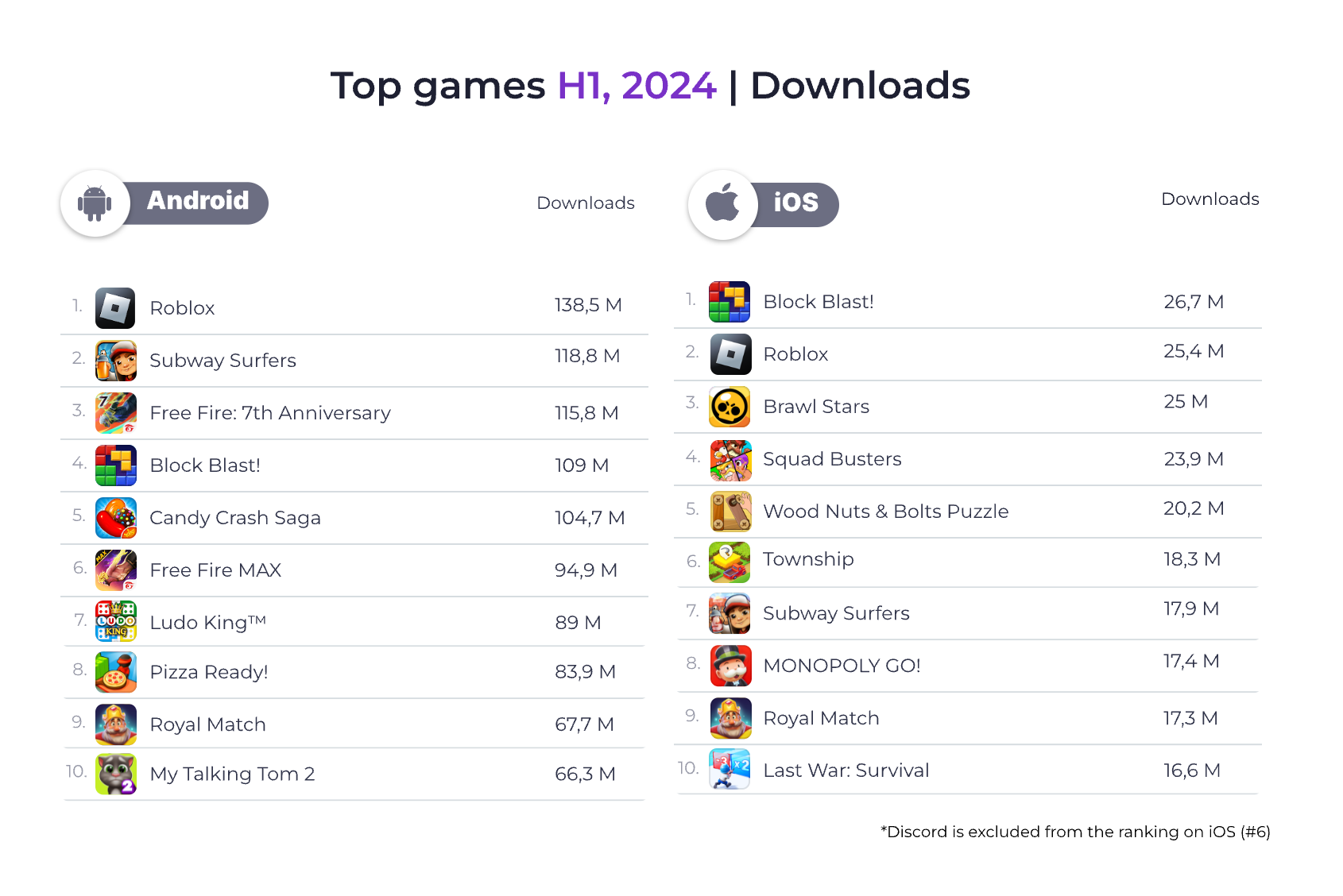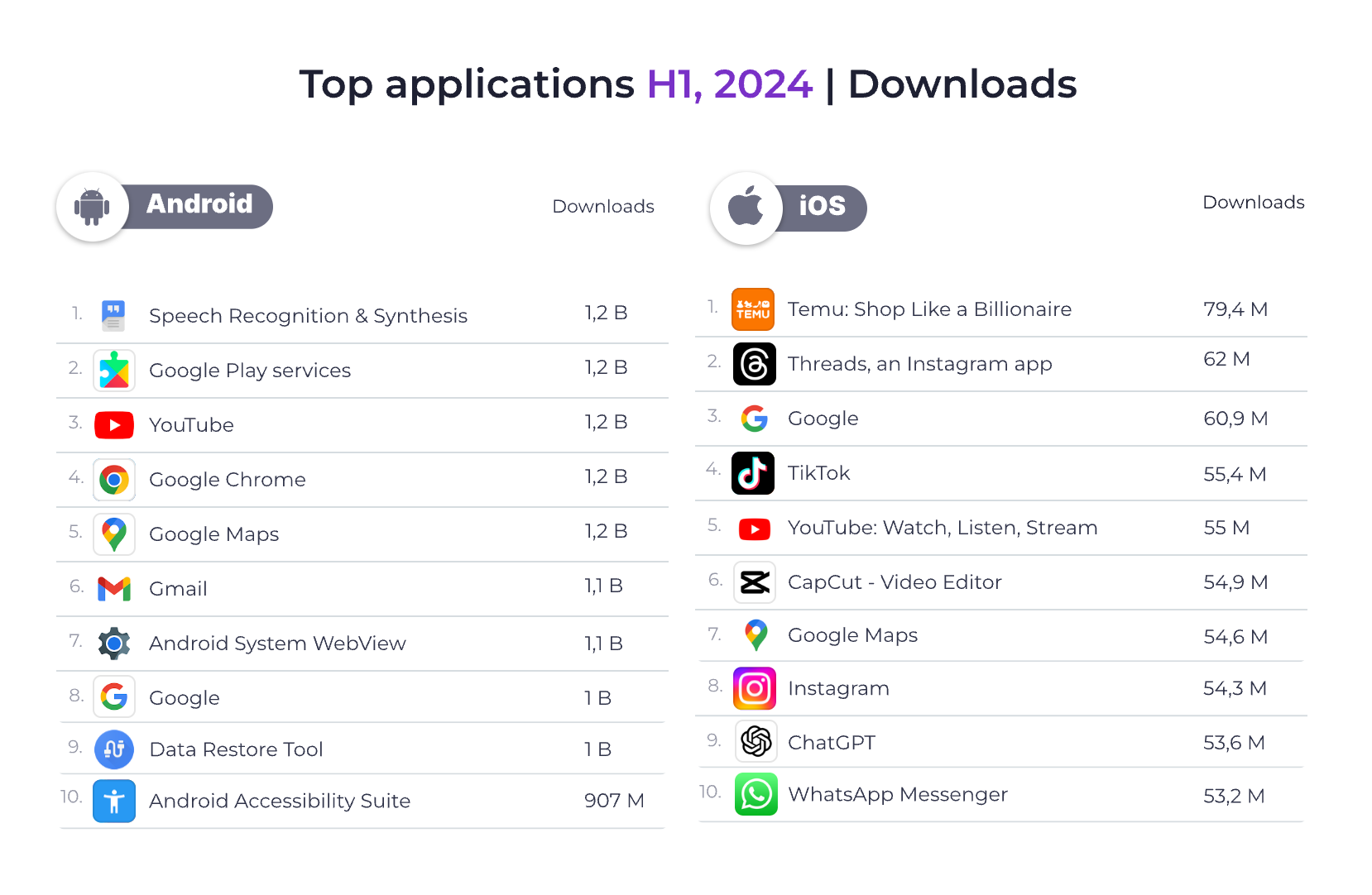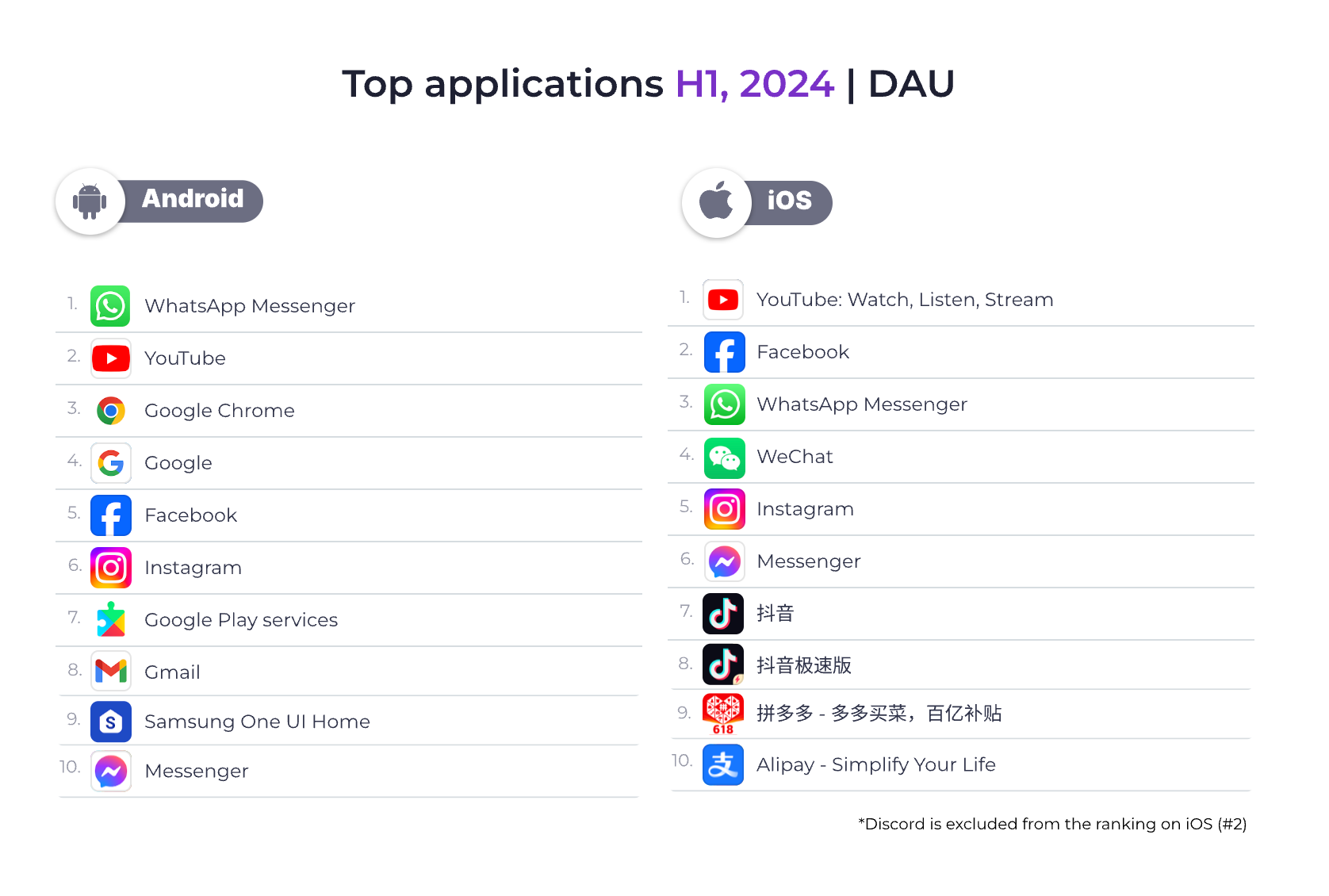Mobile Usage Metrics: What You Should Know in 2024
Explore key app analytics metrics to make well-informed decisions and enhance your user acquisition strategy

Mobile data helps to cater to user needs better. However, not all the insights are equally useful. Sometimes, you just don’t need all the information provided, which is why you need to know what can be cut off.
At Apptica, we hear you. That’s why we’ve prepared a collection of 10 universal metrics you need to track. They are vital to tell whether your user acquisition strategy works correctly. It’s time to explore key app analytics metrics to make well-informed decisions, without having to look through the maze of irrelevant KPIs.
How to Find the Necessary Metrics
Mobile analytics companies like Apptica or even full-scale stores, e.g., App Store or Google Play, provide a plethora of metrics to look into. The sheer volume of the mobile app metrics can be overwhelming.
This is a genuine issue, as an abundance of data adds complexity to the already challenging task of collecting, processing, and analyzing data. Surprisingly, a significant portion of the data collected by enterprises makes up only 30% of all metrics available. It is important to find those and avoid unnecessary ones. Let’s start with reviewing mobile usage metrics.
App installs
This metric is about how many times the app is installed during a certain period. The number of app installs is the foundation for any app analytics.
Google refers to this metric as “Installs,” defining it as the total number of times your app has been installed, including reinstalls. Thus, Google makes no difference between first-time installs and reinstalls.
The App Store uses the “Downloads” metric instead. All the installations are split into initial downloads and subsequent redownloads. A “First-Time Download” is recorded when a user downloads the app for the first time, while a “Redownload” occurs when a user who previously downloaded the app installs it again.


Analyzing your app installs over a specific period, such as a year, can reveal trends in user activity. For example, recipe, food delivery, and gaming apps boast increased downloads during the Holiday season. Knowing such patterns helps to improve user acquisition.
Well-made app ads increase the number of installs. Here is a list of what you can do:
- Optimize app store presence. Improve visibility with ASO tactics like keyword optimization and compelling visuals.
- Marketing campaigns. Utilize social media, influencers, and targeted ads to raise awareness.
- Referral programs. Incentivize users to refer friends with rewards.
- Seek app store features. Aim for featured listings for increased visibility.
- App previews. Create engaging videos to showcase app functionality.
- Localized marketing. Tailor content and ads to specific regions and languages.
- Content sharing. Develop shareable content and enable social sharing within the app.
- Reviews and ratings. Encourage positive reviews and respond to feedback promptly.
- Partnerships. Collaborate with other apps or influencers for cross-promotion.
- Continuous improvement. Regularly update the app with new features.
App uninstalls
Pay attention to app uninstalls. Focus on when the majority of uninstalls happen and how many stages are passed beforehand. This is important to determine the cause of dissatisfaction and address it properly. Common scenarios are:
- Uninstalling immediately after the first launch. Look into app crashes and freezes. Uninstalls may indicate a discrepancy between users' expectations from reading your app store descriptions and the actual functionality.
- Uninstalling during the onboarding (adapting) process. Evaluate your onboarding flow and examine session recordings using privacy-conscious app analysis tools to identify potential issues. Use the LIFT framework to ensure you command just enough credibility, so the user is willing to share their information.
- Uninstalling after a few sessions. Use PageSpeed Insights to verify for performance issues like slow loading times. Ensure your in-app advertising is not overly aggressive, as this may lead to uninstalls. It should be noted that sometimes users compare the apps head-on and then delete unused apps. In this case, you can’t do much, so take it easy.
- Uninstalling after a free trial or after canceling it. Consider displaying a special offer during the trial period.
- Uninstalling after the second or third subscription period, or after using the app for a few weeks or months. Some level of uninstalls is expected, but exploring strategies like introducing new features regularly can potentially retain some users.
App uninstalls are a solid indicator that something is off. Knowing how to localize the problem helps to eradicate it quickly and boost your KPIs.
Uninstalls can happen for many reasons, like app crashes, confusing onboarding, or aggressive ads. To reduce uninstalls, make sure your app is easy to use, clearly explain benefits, and let users skip onboarding if they want. Regular updates and smooth performance also help keep users happy.
App retention rate
The app retention rate refers to the percentage of users who continue using the app after downloading it. Various factors can influence retention rates, with one of the most critical being the user interface (UI).
If users encounter challenges in using or navigating your app, they are less likely to remain engaged. Similarly, if your app lacks unique or valuable features, users may not see the value in keeping it installed.
Ensure mobile app user engagement by making an intuitive and user-friendly (UX) interface while also offering something distinct that sets your app apart from others. If all else fails, focus on unparalleled customer support.
Jovana Stanković, Head of Marketing at REPLUG
Check our webinar on “How to acquire and retain the users in a highly competitive app market” with experts from CleverTap, Tilting Point, ZIMAD & REPLUG and learn about the strategies for pushing installs, insights into user onboarding, and mechanics of retention.

Number of active users (DAU, WAU, MAU)
This collection of metrics tells you how many people use your app regularly. Keep track of the number of active users per day, week, or month to see if there is a trend.
DAU (Daily Active Users) is the number of unique users per day. Consistently high DAU indicators indicate that your product is interesting to users. It is advisable to track DAU on products that people use every day: mobile games, calendars, and email.


WAU (Weekly Active Users) is the number of users per week. A week is not necessarily the period from Monday to Sunday, it can be, for example, the period from Wednesday to Tuesday, i.e., any 7 days in a row. It makes sense to track WAU for products that are used frequently: forums, messengers, or pregnancy calendars, where new useful information is published weekly.
MAU (Monthly Active Users) is the number of unique users per month. MAU metric would be a perfect fit for accounting applications and other monthly accessed apps.
Each metric reflects its own aspect of user behavior. For example, DAU will show the immediate reaction of people to the launch of an app advertisement — if the numbers are growing fast, then app promotion is effective. While the MAU and WAU metrics speak more about the stability of demand for the application.
Stickiness ratio
The engagement rate, also known as the stickiness ratio, measures how frequently users revisit the app after their initial interaction.
A high stickiness ratio signifies that users are actively engaged with the app and derive value from it. Conversely, a low stickiness ratio suggests that users are less inclined to return to the app following their initial experience. Several factors, such as app quality, user interest, and usability, can impact the stickiness ratio.
With our ad intelligence, you can discover applications known for their ability to retain users. It's like finding popular destinations where visitors come back time and again. Gain insights into the frequency of user returns and the factors contributing to their ongoing engagement with these apps.
Conversion rate (CR)
Conversion is a marketing target action. It ranges from a registration to a purchase. Thus, the Conversion Rate (CR) indicates how often the target action is achieved. A high percentage will be evidence of the attractiveness of the site or app for users and that the chosen advertising strategy is optimal. Here are a few ways to increase your CR:
- Check the convenience of the application. The quality of the product is one of the most important factors, because if the application is inconvenient and designed with errors, then the user will leave, no matter how much you try to convert it. And an app with a good user experience (UX) will lead to a good CR.
- Increase the reach of the target audience. It is important to make sure that the right channels are used to reach the audience so that users really learn about the application. Using the ad intelligence section and ad intelligence tools can help.
- Address the audience correctly. An advertising creative must contain the value of the offer, a high-quality mobile app advertisement, and an image. Preferably an interactive one, such as playable ads that will convince the user that they need your mobile app.
Session duration
The session duration of an app refers to the period that a user engages with the app during a single session. The average session duration varies based on the app's category and the demographics of its users.
For instance, weather apps generally have shorter session durations compared to social media apps. This discrepancy arises from the nature of usage, as users usually spend only a few minutes checking weather updates but may dedicate extended time scrolling through social media content.
Additionally, age demographics influence session duration, with younger users typically spending more time on apps in general. However, Gen Z and Millennials are more into visual stimulation, while Gen Z would prefer more focus on personalization. Being able to meet these preferences is the key to prolong session durations.
How to boost retention and session duration metrics?
Retention and session duration rates are crucial metrics to understand user engagement and behaviour since they measure user interactions from a time and recurrence perspective. In this way, having a high retention and session duration rate indicates that users are engaging optimally with an app or website.
To increase these metrics and, therefore, improve the overall user experience, Gamelight experts and Account Managers, José Pedroso and Giulia La Franca, shared some tips.
Include Rewards and Incentives
Leveraging reward points and reward chains, such as level progression, or watching ads, creates a dynamic and engaging user experience. By offering rewards for completing actions or playing for a certain amount of time, users have tangible incentives to continue using the app.
Add Daily Rewards In-game
Daily in-game rewards are a powerful retention strategy, as they prompt users to access the app daily, which creates a habit and fosters regular engagement, which reduces the churn rate. Not only that, but daily rewards also generate a sense of progression and offer instant gratifications, which enhances users’ motivations.
Promote the Social Aspect
Social aspects of the product can be enhanced through various features, such as chat spaces, forums, leaderboards, and rankings. These features strengthen connections, competition, collaboration, and creativity. Ultimately, by focusing on these social elements, the product fosters a community that significantly boosts user engagement.
Offer Personalised Recommendations
Offering a personalised experience to each user by providing relevant content, products, and features that are catered to their individual preferences can boost user engagement and retention. Interacting with content tailored to their tastes improves users’ satisfaction, fosters loyalty, and increases the time spent in the app. This personalisation can be achieved through a thorough analysis of users’ behaviour and preferences. In this sense, it is also important to keep offering new content and features that users can explore and interact with, increasing their session duration rate.
Create an Optimal UX Design
Effective user experience (UX) design significantly enhances retention and session duration. Key practices include creating an intuitive structure, using aesthetically pleasing content and visuals, integrating feedback mechanisms and calls to action (CTA), and developing simple, inclusive features. Overall, good UX design should be user-friendly, efficient, and enjoyable.
Use Push and Pop-up Notifications
Most of the previous strategies – new content, daily rewards, recommendations… – can be boosted through their promotion by push and pop-up notifications. They can not only inform users but also keep them engaged over time and foster a sense of community and competition by embedding the app into their everyday lives.
All in all, according to José Pedroso and Giulia La Franca a high retention and session duration rate is based on the personalisation and intuitiveness of a product, and the leverage of the app affordances to include rewards, new features, and opportunities to socialise. Promoting these practices is key, as it fosters a long-lasting engagement between users and the app, rendering the product more effective.
Average revenue per user (ARPU)
Average Revenue Per User (ARPU) is a metric to assess the financial performance of subscription-based enterprises over a while. Customer LifeTime Value (LTV), on the other hand, has no boundaries. The formula for calculating ARPU involves dividing the total revenue generated from subscribers by the total number of subscribers within a specific period.
APRU helps companies pinpoint user segments that contribute the most to their revenue generated, device retention, and upselling strategies. ARPU is considered a fundamental metric within SaaS and app analytics for pricing, marketing, and sales strategies.
If your ARPU is notably low, it could indicate issues with your in-app purchase strategy. In such instances, consider experimenting with pricing strategies or product offerings.
Implementing app monetization models that combine one-time purchases with subscriptions can enhance your ARPU. One-time products cater to a broad user base and generate immediate income to subsidize subscriptions, which provide consistent revenue streams and contribute to boosting your ARPU metric.
Cost per install (CPI)
You need to know how much you spend (merchant) or earn (affiliate) when conversion fires. In the case of the mobile market, this happens to be installations. Hence, cost (pay) per install (CPI).
The Cost Per Install (CPI) metric is determined by dividing your total advertising expenditure by the number of app installations obtained from the app advertising campaign. For instance, if an advertising campaign costs $1,000 and results in 1,000 app installations, the CPI would be $1.
Don’t forget to pay attention to LTV when analyzing CPI. Initial acquisition costs might be high, but the following RevShare might justify it.
Jovana Stanković, Head of Marketing at REPLUG
Crash rate
Experiencing app crashes can be incredibly frustrating when using your phone. They not only disrupt your activities but can also result in lost data and wasted time. While it's impossible to completely eliminate all app crashes, there are steps you can take to minimize the likelihood of encountering them.
Firstly, ensure that your app is regularly updated. Updates often contain bug fixes that can help prevent crashes.
Secondly, focus on continuous and proper testing. Accurate app testing needs to be performed in several running environments, as well as on different platforms, devices, resolutions, orientations, or networks.
Thirdly, listen to the users and take into account their feedback. Establish social media channels to monitor what the users have to say about your app's performance.
Conclusion
Monitoring mobile app analytics is essential for comprehending and enhancing app usage and performance. Key metrics to monitor include active users, session duration, retention rate, conversion rate, and revenue.
Consistently tracking and analyzing these metrics enables businesses and app developers to gain valuable insights into user behavior and engagement, pinpoint areas for enhancement, and make well-informed decisions regarding app development and marketing strategies.
Utilizing tools from Apptica can greatly assist businesses and app developers in tracking and analyzing KPIs to optimize mobile app analytics metrics to increase active users, enhance retention and conversion rates, and ultimately boost revenue and expansion for your app.
FAQ’s
What is the significance of mobile app metrics?
Mobile app metrics provide insights into how users discover, engage with, and disengage from your app. They offer data-driven insights to sustain and expand your app business.
How can I monitor these mobile app metrics?
You can track mobile app metrics using the built-in reporting provided by app stores, Apptica app analytics tools, and custom data reporting options.
What actions can I take to enhance user retention?
Implement various strategies such as personalizing the app user experience, consistently introducing new features to add value for users, and incentivizing app usage to boost user retention rates.
What are effective methods to reduce Cost Per Installation (CPI)?
To decrease CPI, analyze your advertising data to identify cost-effective keywords for bidding while still generating app installs. Additionally, monitor the long-term in-app behavior of paid leads generated by these keywords.
How can I minimize error rates in my app?
Conduct comprehensive testing using automated and manual methods to detect errors. Investigate common issues leading to errors and evaluate how your app handles them. Plus, listen to the users and their feedback, when it comes to locating problems.





